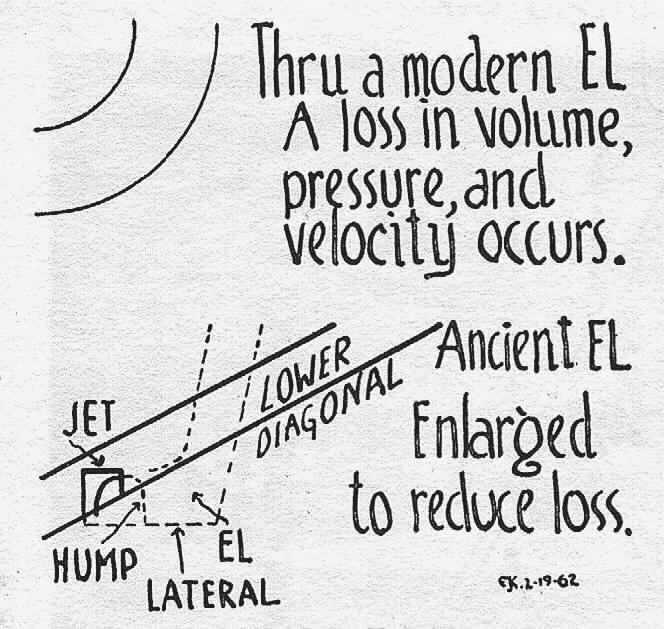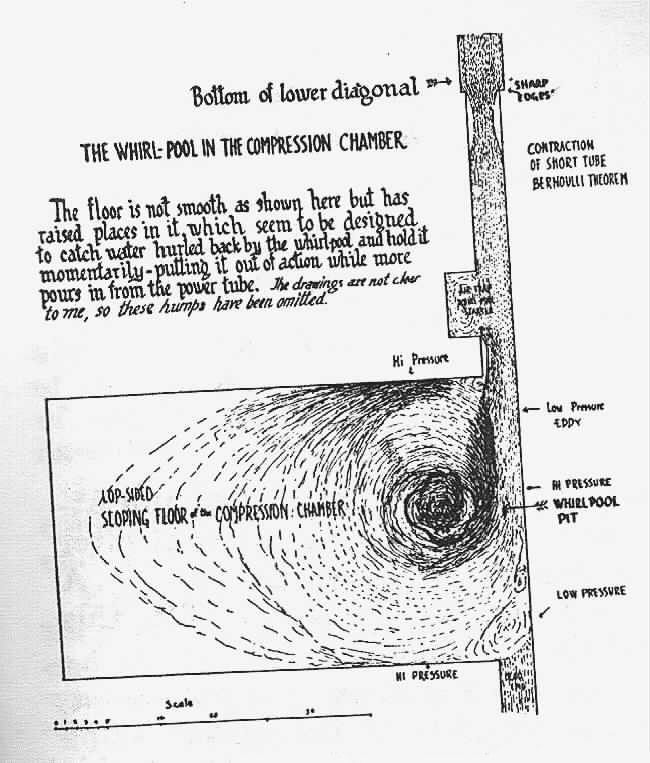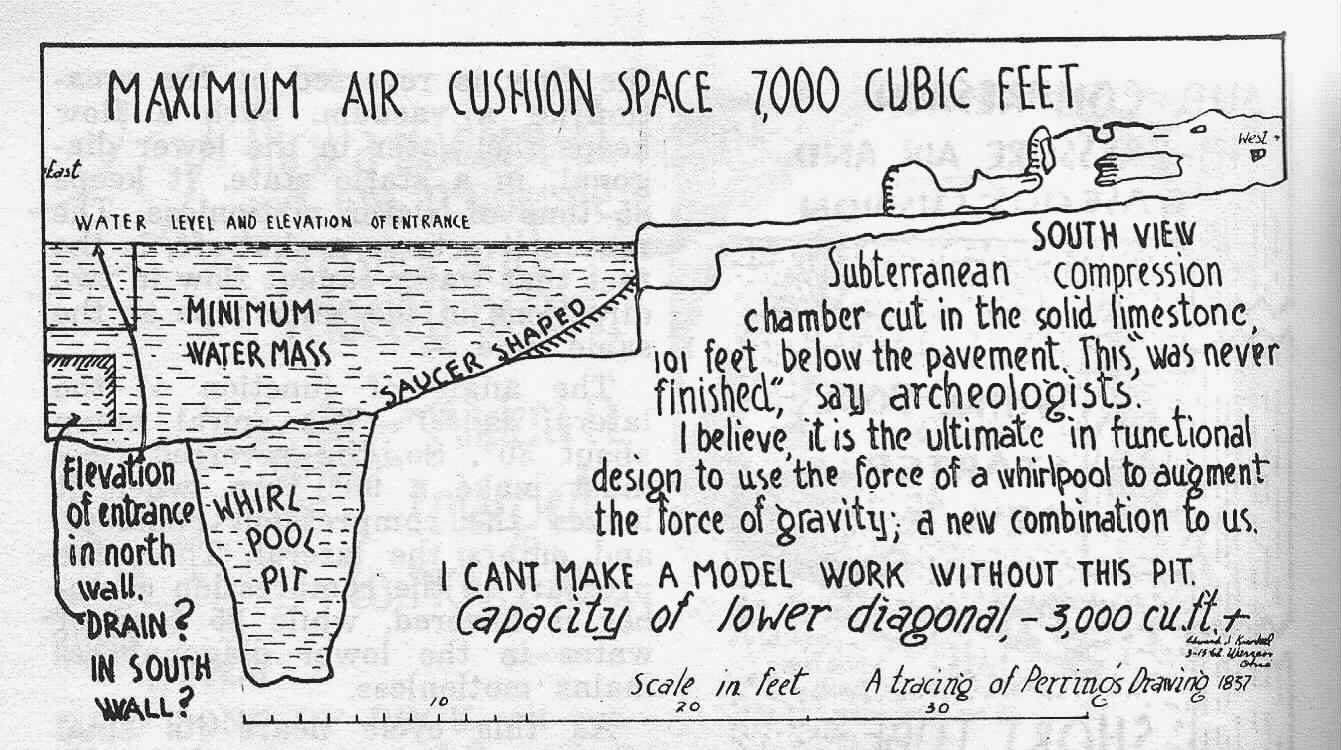

How the Great Pyramid
At Giza was built, and Why!
 Jet
and Subterranean Chamber
Jet
and Subterranean Chamber
 There are many more refinements to the simple diagram above and the animated
image that are discussed in the book Pharaoh's Pump. Space constraints
do not allow for all the text and images that I would like to add to this
site. The complete information is located in the book Pharaoh's Pump!
This chamber would coincide with a compression chamber in a water ram pump.
The kinetic energy of the moving water down the lower diagonal causes the
water to compress air in the subterranean chamber. When the air cannot
be compressed any more the water stops moving in the lower diagonal.
This causes the check valve in the top of the lower diagonal to close.
The compressed air would then push water up to the lower part of the Grand
Gallery helping to raise that column of water. To get a better understanding
of how the two passages that lead down to this chamber from a water pump
go to How the Great Pyramid was Built.
Below are excerpts form the book.
There are many more refinements to the simple diagram above and the animated
image that are discussed in the book Pharaoh's Pump. Space constraints
do not allow for all the text and images that I would like to add to this
site. The complete information is located in the book Pharaoh's Pump!
This chamber would coincide with a compression chamber in a water ram pump.
The kinetic energy of the moving water down the lower diagonal causes the
water to compress air in the subterranean chamber. When the air cannot
be compressed any more the water stops moving in the lower diagonal.
This causes the check valve in the top of the lower diagonal to close.
The compressed air would then push water up to the lower part of the Grand
Gallery helping to raise that column of water. To get a better understanding
of how the two passages that lead down to this chamber from a water pump
go to How the Great Pyramid was Built.
Below are excerpts form the book.
There are two subterranean shafts. One is a rectangular symmetrical
diagonal, while the other is about 30 inches square with rounded corners,
and follow an irregular course downward.
From ground level, the mouths of these shafts are about 160 feet apart,
but as they descend they come closer together and meet at a depth of 89
feet; the result is the formation of a bastard U tube.
The junction can be defined as a lateral connection. The lateral
is short, and in a horizontal position. At one end of it is a ENLARGED
ELL, while; at the other end, where it joins the diagonal, is a nozzle
or jet formation.
It can truly be called a jet because the aperture is smaller in cross-section
than the lateral. In fact, it is about one-third smaller. — It constricts
the flow through the lateral, therefore, water flowing through the lateral.
— It squirts, like a nozzle. The lateral enters the lower diagonal, at
an acute angle of 30 degrees. Its mean length is 6 ¾ feet long.
Eight feet long on one side and 5½ feet on the other. The
ceiling appears to be arched, the walls vertical, and the floor flat, but
the junction of the walls and floor is rounded.
Constriction of the jet is formed by its odd connection with the lower
diagonal. The opening is reduced by the triangular member marked
“LOWER DIAGONAL”.
It is unique as a jet; because it lacks a certain symmetry, it measures
3 feet across the top. One side is also 3 feet high, while the other
is 4 inches, and conforms to the pitch of the diagonal.
The jet has another odd mechanical feature, or element.
 Within the jet, a spiral hump is found. It is carved in the living
rock. This hump emerges from one wall near the bottom, arches up
over the top, and disappears in the opposite wall. Water
Within the jet, a spiral hump is found. It is carved in the living
rock. This hump emerges from one wall near the bottom, arches up
over the top, and disappears in the opposite wall. Water
flowing down the lateral connection and through the jet, will start
to spin or twist in a counter clockwise direction.
After experimenting with a model of this ancient pump, I have come
to the conclusion, that this spiral hump, had a dual function; quite unique
in the field of hydraulic engineering. Briefly, the function was
this; it acts as a shut-off means in the lower diagonal, when the flow
is reversed by the creation of a vacuum. Such a flow keeps the water
in the lower diagonal, in a static state. It keeps 85 tons of water
motionless. The reason it acts as a shut-off, is the fact that water
cannot flow in two directions in the same pipe at the same time.
The angle of junction of the lateral is 60°. The spiral hump
about 30°. So the reversed flow must take a 90° turn, when
it leaves the compression chamber, and enters the lateral. Thus,
the pressure in the compression chamber is lowered, while 85 tons of water
in the lower diagonal remains motionless.
As this cycle nears its final phase, and at least stops, the static
column begins to move, all hell breaks loose; because the shut-off means
has been holding back some 85 tons of water, while at the same time the
pressure in the compression was being reduced; thus, offering very little
resistance to the moving column in the lower diagonal.
What man can calculate the gaseous cushion pressure per square inch
in the compression chamber, when 85 tons of moving water is doing the compression?
Then add to this the resistance to flow has been reduced.
Some observers write, that the rectangular symmetrical diagonal shaft
is wider than high, while other say the opposite, but all agree that it
is 3 feet 5½ inches, by 3 feet 11 ½ inches. Perring
shows it higher than wide. Perring is correct.
This section is 220 feet long; and descends at an angle of 26 degrees,
41 minutes. — So perfect is its alignment; that one can sit at the bottom
and see the sky. — And being rectangular in form, the friction of flow
is reduced to a minimum.
 “Liquids and gases flow free, that is; with less friction through
a square tube, than that of any other shape.”
“Liquids and gases flow free, that is; with less friction through
a square tube, than that of any other shape.”
If this tube were filled with water, it would hold 88 tons. The
static pressure at the base would be about 40 pounds per square inch; because
its depth is 100 feet.
This rectangular, precision-cut shaft is the supply tube for the pump.
— It is where the water comes in. It is the intake.
Henceforth, this shaft will be called the LOWER DIAGONAL.
The diagonal shaft ends, 23 feet below the jet. The end of the
diagonal is joined by a rectangular shaft, smaller in cross-sectional area
than the diagonal, and cut in a horizontal position. (I’ll call it
the short tube.)
This short tube leads to a huge rectangular chamber with the entrance
in the precise northeast corner of the chamber.
This chamber is 100 feet below the pavement of the pyramid. It
is 46 feet long, 27 feet wide, 5 ½ feet high at the west end, while
at the east end, the height varies from 11 to 13 feet.
The floor slopes downward from west to east. Water in it will
drain toward the entrance.
The ceiling is truly rectangular in shape, while the north, east, and
south walls are trapezoidal. The floor is lop-sided.
This huge chamber, cut in the solid limestone is airtight. — Add a
few thousand gallons of water, and the imprisoned air will form an air
cushion, with the air compressed against the ceiling. — This chamber then
becomes, an air compression chamber, capable of holding compressed air.
— Air in it can be compressed to the nth degree, and then some. — here
is an air compression chamber — Early 2,000 B.C. MODEL.
 Near the center of the floor is a dished-out, saucer-like cutting, about
20 feet in diameter. (I’ll call it the saucer.) Near the middle
of the saucer is a pit, 7 feet in diameter, and 9 feet deep; fashioned
like a malformed tumbler, or cup.
Near the center of the floor is a dished-out, saucer-like cutting, about
20 feet in diameter. (I’ll call it the saucer.) Near the middle
of the saucer is a pit, 7 feet in diameter, and 9 feet deep; fashioned
like a malformed tumbler, or cup.
If a mechanical means can be devised, whereby water in the lower diagonal
can be caused to move, water will enter this chamber at an extremely high
velocity.
When water enters the orifice its current sets up a rotary motion in
the saucer, while a whirl-pool develops in the pit. The action reduces
the water pressure at the orifice, because the whirling water is rotating
in the same direction as the stream entering the chamber. This action
increases the velocity of the water flowing down the lower diagonal, because
the pressure at the orifice is reduced. Thus, does the whirlpool
augment the force of gravity.
I have experimented with a small model of this pump, and for a long
time could not account for the violent reaction of this particular part,
because the only expenditure of energy, was my breath. When I blew
down the jet-bowl tube, a got a discharge of about half gallon of water,
and some of it traveled a distance of 22 feet. It was some time before
I realized that a whirlpool which I could not see, had developed in the
well, and was at work, and particularly responsible for his violent action.
I made another model without the well and it did not work at all. —
I was quite sure that I had rediscovered a new force; a whirlpool in an
airtight tank, to do work. The horizontal connection which joins
the lower diagonal with its compression chamber is, 27 feet long, 3 feet
high, and 2 feet 9 inches wide. It is 5.7 square feet smaller in
cross section, than the diagonal. —The junction of the tubes is abrupt.
— The top and sides of the diagonal are cut at right angles to its pitch,
and form three distinct edges. — In short, this junction forms a contraction
of the diagonal.
Bernoulli discovered, that if an orifice of a tube had clean sharp
edges, and the tube was no longer than three times its cross-section dimension,
that the discharge from such a tube will be increased by more than 25%.
This is known as the principle of the standard short tube.
The horizontal connection which joins the lower diagonal with its compression
chamber is nearly square in cross-section, and its length is almost precisely
9 times this dimension. This variance of proportion may be accounted
for, by the fact that the ancients were working with a hundred foot head
of water. The clean sharp edges form three sides of the junction
where the horizontal and the lower diagonal meet, although some of its
clean sharp edges have taken a terrific beating from souvenir hunters.
While Bernoulli’s Theorem calls for a tube 3 times longer than its
diameter, here is an application where it is more than 9 times longer.
This variance of proportion may be accounted for, by the fact; that the
ancients were working with a one hundred foot head of water, and a volume
of 80 tons, plus — Too, I suspect that the increased discharge exceeded
the accepted maximum of 33% this would seem to indicate that the
ancient hydraulic engineers know more about Bernoulli’s Theorem, than Bernoulli
did; because this short tube is 27 feet long.
One thing more about this tube. — Seventeen feet beyond the clean
sharp edges is a cub-like cell. It is six feet square on plan, and
4 ½ feet high.
I deduced that the cell is the whirlpool starter; and that its
function was to overcome the inertia of mass in the compression chamber
and start the whirlpool spinning.
It worked this way: air trapped at its tiny ceiling formed an
air cushion, and the instant a downward flow occurred, the air pressure
in the cell became unbelievably high, and seeking relief moved the water
between the cell and the chamber, and thus; initiated the action, which
a moment later developed into a whirlpool. — A model worked better WITH
this cell than without it.
Since, the subject of the moment, is the function of the underground
cuttings, it is appropriate at this time, to mention a mechanical element,
which apparently has no function, although it may have a function; which
is elusive at present.
The mechanical element? — A dead end shaft, cut in the south-eastern
corner of the compression chamber.
It is 52 feet 9 inches long, 2 feet 7 inches wide, and 2 feet,
5 inches high.
Its direction is from true north to south.
Its position is horizontal.
It lies at the lowest corner of the chamber.
Its position suggests, that it could be a drain: but it dead
ends in the rock. Even though it is 105 feet below the base of the
building; it is still high enough from the outside to function as a drain.
Apparently this dead end has never been examined; with the idea
in mind, that it may be a drain duct.
 Home | FAQ
Links
Please send comments or questions regarding these web pages to
Pharaoh's Pump Foundation
Copyright © 1998 Pharaoh's Pump Foundation.
Home | FAQ
Links
Please send comments or questions regarding these web pages to
Pharaoh's Pump Foundation
Copyright © 1998 Pharaoh's Pump Foundation.





